Nordkalottleden
Nordkalottleden (Swedish), Nordkalottruta (Norwegian), Kalottireitti (Finnish) or the Arctic trail is a long-distance hiking trail in Finnish Lapland (70 km), Northern Norway (380 km) and Swedish Norrland (350 km), crossing borders many times. It features varying Arctic fell landscapes, including high fells, fell heaths, lakes and fell birch forests. Much of the trail is above the treeline, on two legs for several days.
- This article is an itinerary.
Most of the trail is through wilderness, often with roads or dwellings not seen for days. The only town close to the trail is the small Kautokeino at the northern trailhead. In season you will meet people, but not every day, and even on the most busy stretches not all the time. Much of the trail, perhaps half of it, is through national parks and other protected areas. The area is used as reindeer pasture and for fishing, berry picking and similar, so there are locals, but population is very sparse.
Understand
- See also: Hiking in the Nordic countries, Right to access
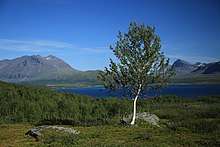
The trail goes through Arctic wilderness, including some rough terrain at quite high altitudes, with long distances between huts on some legs. You should be reasonably fit and at least somebody in the company should have enough hiking experience and experience of handling cold weather. You should also have equipment that you can trust in adverse conditions. The trail is in no way extreme, but you should be able to handle also unlikely nasty surprises, as in finding an alternative route if the spring floods took your bridge, or as in waiting out a snow storm in summer. Some legs are suitable also for a less experienced company.
Distance between huts varies from 10 to 50 km, depending partly on popularity of the specific leg. Also standards vary considerably, from the Spartan open wilderness huts in Finland (and a few minimal turf huts and emergency huts you can choose to use) through the obetjent variety of Norwegian huts and manned Swedish huts with some service but with the expectation of guests taking care of themselves, to the fjällstation with restaurant and at least hostel like accommodation. As you will probably be carrying your own tent, hiking mattresses, sleeping bags and cutlery anyhow, the standard of individual huts is not necessarily that important, but some extra service may feel good after days in the wilderness.
You can follow marked trails all the way in normal conditions, but the markings, the terrain and the condition of the trail vary quite a lot. Although you may find your way easily on some legs, using your map is necessary on others. Fog is common on some legs, and reduced sight can be a major problem in open areas. Much of the time you walk on rolling fell heaths and through sparse fell birch forest, where walking is easy, but there are quite a lot of legs with steep grades, and there are passages where the terrain is mostly boulders and good boots are needed. There are many fords, some of which can be difficult or even impossible at high waters, and quite some wetlands on some legs. You may see several glaciers, but you do not have to cross any. No climbing either – unless you choose such a sidetrip.
The trail was opened in 1993, mostly combining existing shorter trails. It coincides with other trails on a number of legs, notably with the newer European long distance path E1 from Kautokeino to the tripoint after Kilpisjärvi and perhaps elsewhere, with Grensesømmen from the tripoint to the Ny Sulitjelma hut, with Nordlandsruta (part of?) the distance from Gautelihytta to Ny-Sulitjelma, and with the Padjelantaleden and Kungsleden on some legs. Some of these other trails are much more busy than the Nordkalottleden, so you may walk for days hardly meeting anybody and then find more people on the trail and huts crowded the next few days. Huts close to trailheads are also likely to be more busy, but as trailheads usually are on the end of a long dirt road, often a day's hike from Nordkalottleden, day hikers are not a common sight.
The right to access allows you to deviate from the trail if you like, also when there is no alternative marked route. The trail may be flooded by a river, a bridge may be absent, or you might want to climb a nearby peak or pick berries on a bog, or just prefer another route. In some areas the right is however restricted, mostly in nature reserves. Check the rules for such areas and be cautious in any unfamiliar type of terrain (as there sometimes is a serious reason for the trail to avoid a seemingly nice route).
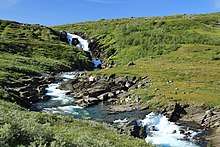
Mosquitos, black flies and their friends (known collectively as räkkä in Finnish) are a nuisance in the Nordic summer, here in the north more or less from Midsummer to August. The Nordkalottleden trail is above the treeline for much of the distance, where the wind keeps most of them away, but in valleys they may be plentiful, and on still and moist days there may be quite some räkkä also on higher ground. Long sleeves, insect repellent and a mosquito hat – and a mosquito-proof tent – may be necessary to keep you sane (the räkkä is not otherwise dangerous: they carry no diseases and you need to get hundreds of bites for them to affect you other than having the itch). Keep the door closed when using huts. You could also time your trek for August–September, when most are gone (although exact dates vary by year and location).
There is plenty of good water along the trail, so you need to carry water only for some hours' need. In warm weather you might want to boil it for a few minutes to be safe, but few hikers bother to. Streams coming directly from glaciers (you will notice the strange colour) has lots of particles and should not be used for drinking or cooking.
You are allowed to make campfires on most of the trail, unless there is risk for wildfire (announced or otherwise). In Norway open fire is also disallowed in or near forests in summertime, except at designated camp fire sites, in Finland you always need landowner permission, but you have it in the Käsivarsi Wilderness Area. In Sweden campfires are generally allowed, but restricted in Abisko National Park. There are long distances with little firewood. There are cooking facilities in the huts, but some huts may be crowded. A portable stove is more or less necessary.
The trail is described from north to south. That way you gain in mountain height but lose in latitude. The other way round could be equally good.
The Sámi

The trails goes through the homeland of the Sámi. Until motorized terrain vehicles where introduced, the Fell Sámi followed their herds as they moved from winter pastures to calving lands and on to the summer pastures. The goahtis and lávvus have been complemented by huts and houses, but some Sámi still move between winter and summer lands. Along the route you may encounter Sámi camps or villages. At some such locations you may be able to buy fish and bread, and perhaps some other produce.
When you meet reindeer – and you will – avoid disturbing them. This is especially important in calving times and when they are gathered or form more close herds to wander to other pastures. In early summer the reindeer are gathered to mark the calves and in autumn for taking some to slaughter. A split herd means a lot of extra work. If a herd is coming towards you, sit down and wait quietly until it has passed. When not at calving grounds or on the move, the reindeer are less sensitive. They will still not let you near.
Dogs must be on a leash and are disallowed in many huts and have to stay on the trail in some areas. They might be disallowed on the route between Reisa and the tripoint (because dogs must pass the Finnish border at official border crossings?) and in Padjelanta.
Season
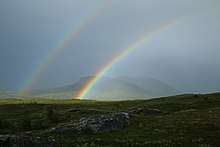
The itinerary is about hiking in the summer, perhaps July to mid-September. In this period temperatures can be expected to vary between freezing and about +25°C (80°F). If you get cold weather with rain and wind you need proper gear, but you may as well get warm days with sunshine – or days with sunny weather between the showers.
DNT (ut.no) gives the season as May–Oct, but in early summer – even July at some points – there may still be quite some snow in the mountains, and high waters in the streams, and from late September snowfall becomes increasingly likely, and hiking without skis in deep loose snow is not nice. Off season some cabins are closed or unmanned, and provisions for sale may be scarce already shortly before. Also some bridges are removed when the summer season ends (often indicated on the map: "sommarbro"). At least if you go in May–June or October you should double check what to expect.
As the season for the trail is summer, you will not have much darkness in the night. In the south end of the trail you will probably not see the midnight sun, but there are white nights until early August, and even in mid-September there are just nine hours between dusk and dawn (as defined by "civil twilight"). In the north end the midnight sun persists until late July, white nights until mid-August, and even in mid-September natural "light pollution" will affect stargazing throughout the night.
It may be possible to ski the route in winter, and certainly is for some legs, but the issues involved are not handled here. On some legs the route has to be adjusted to avoid avalanches, and on most legs the markings are not made to be seen above the snow.
Sleep
There are wilderness huts along all legs of this itinerary, but at some points the distance may be too much for one day's hiking (50 km between Røysvatn and Vaisaluokta, some more 30 km distances). Staying a night or two on an independent trek is allowed in all these huts, check if you want to stay longer or are arranging a commercial hike. Use the guest books found in the huts: they may be fun to read on rainy days, they provide information to fellow hikers and maintainers of the huts, and they help rescue teams direct their search to the right area (do note changes in your plans).
Most lodgings below are linked to their web page (Norwegian only for DNT huts, learn to recognize and understand the standard info), but some information on those pages (at least at STF) is default wordings, which may not be accurate. Use due care when interpreting them, and do not rely on descriptions matching reality.
A tent is a good safeguard if you have to camp because of bad weather or if some huts are crowded – and you might prefer camping in a nice spot by yourself when the weather is good.
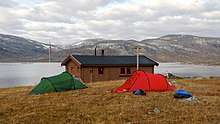
Most cabins/huts in Norway are maintained by some branch of Den Norske Turistforening (DNT), along this trail Troms Turlag or Narvik og Omegn Turistforening. Most of the Norwegian huts on this itinerary are the unmanned obetjent variety, locked with the DNT key. Register your arrival first thing when using the DNT huts. There are also a few free unlocked huts maintained by the governemental Statskog on the northernmost leg and at least one nødbue, i.e. emergency or day hut, in the Narvik fells.
To get the DNT key, you might have to become member of DNT, the Swedish STF or the Finnish Suomen Latu. What "sister organisations" count seems to vary depending on who you talk to, you could try yours. Membership is not required for actually using the huts, just for the key, so if somebody is there (or one in the company is member), you just pay a higher fee as non-member. If you intend to use huts, the membership fee (single adult: DNT 680 kr) can quickly pay back in the form of lower hut fees. The physical key is borrowed for a small deposit. In theory you might have to go to a DNT office, but you can get it in other ways, at least in Abisko and from the customs in Kilpisjärvi, perhaps even mailed. Check details from where you would like to get it (and return it, unclear how the deposit works if not the same place).
The Swedish unmanned huts are unlocked, but most Swedish huts are manned in season and have some service and opportunity to buy food. Large groups should announce their arrival beforehand. If you have paid in advance, have the receipt with you as there may be no online connections. Otherwise reserve cash for the manned huts, for the same reason. Unmanned huts can also be paid later (fill in a form available in the hut).
Finnish reservable huts are locked and paid in advance, while Finnish unlocked huts are free. Neither type has personnel or food. The key for the reservable huts can be fetched in Kilpisjärvi (either the visitor centre or the customs, information differ), possily also in Hetta. Other arrangements may be possible. Check also how to handle the deposit.
In the Finnish open wilderness huts and the Norwegian nødbue you need your own mattress and sleeping bag (and pillow, if you want one), in the other huts own sheets mostly suffice – but you will need a tent and sleeping bags anyway on most legs. Accommodation in the more Spartan huts is in bunk beds in a single shared room also acting as kitchen and living room. In Norway and Sweden there are often a few separate dormitories. There are spare mattresses in the Norwegian huts for those sleeping on the floor when the hut is crowded. Own toilet paper is often needed.
The Norwegian hytte typically have lighting by solar power (no outlets for your devices, though). The Finnish huts and the more primitive lodgings have no lighting. In summer you probably do not need a torch in your tent, but you might want one in the huts.
The fee for lodging in the Troms Turlag huts is 300/120/60 kr/person for non-members, 150/60/0 for members, day visits non-members 60 kr, members 30 kr. In Narvik og Omegn huts the fees are 300/150/75, 150/75/-, camping by hut 150 if hut used, 75 otherwise, day visit 50. In Sulitjelma og Omegn huts the fees are 250/150/- for non-members, 150/75/- for members, 20 for day visits. In Finnish reservable huts the fee is €12/person. In the fjällstuga of Svenska Turistföreningen the price for non-members is 460–520/150 kr at Kungsleden, 410/150 kr elsewhere, members 360–420/50 kr at Kungsleden.
In open wilderness huts, the last to arrive have an absolute right to the facilities – somebody arriving in the middle of the night is probably in dire need of shelter. Those who arrived earlier arrange room by tightening up or by going to sleep in their tent (if you arrive early, put it up, in case). The same is mostly true in the other huts, but they usually have more space.
On this trail, camping is allowed in most places. If you camp by a hut, other than a Finnish open wilderness hut, you should pay for using the facilities, but in Sweden and the Narvik fells the fee is significantly lower than for sleeping indoors. Camping in Malla Strict Nature Reserve and in Abisko National Park is allowed only by the huts. There may be other small areas with restrictions.
Rivers
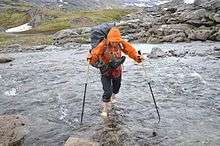
There are many rivers to be crossed on the route. The large ones should have bridges, but minor ones have to be forded – and also minor ones may be difficult to ford at high waters. There is some advice at Hiking in the Nordic countries#Fording.
Prepare
National park visitor centres serving the areas should be happy to help you with any information you need, at least to provide pointers.
There are a few villages and manned or self service huts along the trail, where you can replenish to some degree, but these services do not cover all the trail. Plan well and be prepared to carry quite much food. You might be able to arrange replenishment to points with no shop, but close to road connections. The trail is 800 km in all. Most people hike only some legs, or at least split the trek over several years.
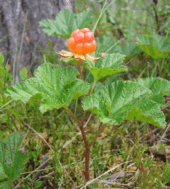
You are allowed to pick berries and mushroom (at least outside strict nature reserves). In August there should be cloudberry in the bogs and crowberry on the fell heaths; bog bilberry (ssp. microphyllum) may grow in some areas. Learn to know those. Picking cloudberry is restricted in Norway, but you are at least allowed to pick as much as you want for immediate consumption. For mushrooms, normal warnings about poisonous ones apply. If there are safe new acquaintances, remember to eat very moderately, as they sometimes can upset your stomach on first try.
Fishing is possible at many locations, but requires permits (the exceptions apply in few waters along this trail). You should also plan for treatment against the Gyrodactylus parasite, which occurs in rivers flowing to the Baltic and in some flowing to the Atlantic, either chemically or by drying equipment (including boots) thoroughly. For rivers flowing to the Atlantic, infection will destroy the salmon population.
The trail meanders between Norway, Finland and Sweden, but all three countries belong to the Schengen Area so you do not have to care too much about the borders. If you have a dog or something needing custom clearance you should check what advance arrangements are needed.
English is well understood in all three countries, but for place names it is good to be aware of the local languages. In addition to the national ones, Sámi languages are used along the trail, and there may be older spelling varieties on the maps. Sulitelma and Sulitjelma are the same mountains, Raisjärvi, Ráisjávri and Reisavann are the same lake, and Kuonarjoki and Guonjarjohka are the same river. Mind though, that there may be similarly named places, and that many villages are named after some nearby lake or fell (so Sulitjelma may actually refer to the village, and Kuonarjoki to the hut). Use some time with a bi- or threelingual map to get a feeling for how names change between languages (Norgesglasset can give names in all relevant languages when clicking on a location; Kven is more or less Finnish).
If you want a guaranteed bed in Finland you need to reserve it, pay and get the key. Check what deposit is needed, where you can get the key and where you can leave it. For other lodgings reservations are seldom needed, but you may want to check that the hut is not used for any bigger event. And you probably want the DNT key. It may be both cheaper and more convenient to pay for some lodging in advance, and for any special wishes, make the contact early, as the hut cannot always be reached by telephone.
- Statskog, ☎ +47 74-21-30-00, e-mail: post@statskog.no. M–F 08:00–15:30. Some huts and cabins between Kautokeino and Saraelv.
- Fell Lapland Nature Centre (Hetta), ☎ +358 20-639-7950, e-mail: tunturi-lappi@metsa.fi. M–F 09:00–16, Mar–Apr and Jun–Sep daily 09:00–17:00. Info on Käsivarsi Wilderness Area.
- Troms Turlag, Kirkegata 2, Tromsø, ☎ +47 77-68-51-75, e-mail: troms@dnt.no. W 12:00–16:00, Th 12:00–18:00, F 12:00–14:00. Two cabins in Reisa, most of the cabins between the tripoint and Abisko.
- Swedish Tourist Association (Svenska Turistföreningen), ☎ +46 8 463-21-00, e-mail: kundservice@stfturist.se. M–F 09:00–16:00. Most of the Swedish cabins.
- Laponia Visitor Centre (Naturum) (Stora Sjöfallet), ☎ +46 973 220-20, e-mail: naturum@laponia.nu. March–September. Info on the Laponia area, although cabins are operated by others.
- Badjelánnda Laponia Turism, ☎ +46 70 281-30-03 (difficult to reach in summer), e-mail: padjelanta@padjelanta.com. The cabins in Padjelanta (part of Laponia)
- Narvik og Omegn Turistforening, e-mail: narvik@turistforeningen.no. The Norvegian cabins between Sälka and Vaisaluokta.
- Sulitjelma og Omegn Turistforening, Postboks 300, 8201 Fauske, e-mail: sot@turistforeningen.no. The last cabins on the route to Sulitjelma.
If you have a dog, check the regulations for passing the border with all countries, and note where the dog is allowed. Mostly having the dog in leash is enough, but at some legs you are not allowed to deviate from the trail with a dog and in Padjelanta dogs are disallowed altogether in summer. In some huts dogs are allowed if other hut users agree, in some a separate department (or separate hut) can be used with dogs. Have something to put on the floor for the dog to lie on, don't let it up in beds or chairs.
Maps
For planning, online maps provided by DNT, Norwegian Kartverket, Finnish Metsähallitus and Swedish Lantmäteriet can be used. Some of these are useful also for navigation, but you do not want to rely on online connections; for the hike you will need proper maps.
Usually the map ends at or close to the border, so you may need maps from all three countries. There is some tradeoff between how many maps to buy, how old the maps are (years below given as of autumn 2016), and how big a scale to afford. There may also be differences in how clearly the hiking insfrastructure is marked.
(The publisher is below given as a code: Sk=Statens kartverk, Norway; U=Ugland It Group AS, Norway; L=Lantmäteriet, Sweden; K=Karttakeskus, Finland.)
(Lists not checked, use with care.)
First (Finnmarksvidda):
- Siebe 1832 I (2001 Sk) 1:50 000
- Guovdageaidnu 1833 II (2001 Sk) 1:50 000
Then either these (Reisa and Finland):
- Ráisjávri 1833 III (2002 Sk) 1:50 000
- Čierte 1733 II (1989 Sk) 1:50 000
- Mollešjohka 1733 I (2008 Sk) 1:50 000
- Ráisduottarháldi 1733 IV (2008 Sk) 1:50 000
- Reisadalen 1734 III (1999 Sk) 1:50 000
- Enontekiö (2004/5 K) 1:100 000
or this:
- Turkart Nordreisa (2008 U) 1:100 000
Then these (the tripoint to the border near Abisko):
- Fjällkartan Treriksröset-Råstojaure BD1 (1999 L) 1:100 000
- Rostadalen 1632 IV (2005 Sk) 1:50 000
- Julosvárri 1632 III (2005 Sk) 1:50 000
- Altevatnet 1532 II (2006 Sk) 1:50 000
- Salvasskardet 1532 III (2004 Sk) 1:50 000
or these:
- Fjällkartan Treriksröset-Råstojaure BD1 (1999 L) 1:100 000
- Turkart Bardu (2004 U) 1:100 000
Then these (Abisko to Padjelanta):
- Turkart Rádjebálges (2008 U) 1:100 000
or these:
- Fjällkartan Abisko-Kebnekaise-Narvik BD6 (2003 L*) 1:100 000
- Fjällkartan Sitasjaure-Ritsem BD7 (2003 L) 1:100 000
or these:
- Skjomdalen 1431 III (2002 Sk) 1:50 000
- Frostisen 1331 II (2002 Sk) 1:50 000
- Bjørntoppen 2230 I (2005 Sk) 1:50 000 (Røysvatnhytta here in wrong position)
- Vuodnabatha 2230 IV (2008 Sk) 1:50 000
Then this (Padjelanta to Sulitelma):
- Fjällkartan Padjelanta-Sulitelma BD9 (2003 L) 1:100 000
or these:
- Fjällkartan Sareks Nationalpark BD10 (2003 L) 1:100 000
- Låmivatnet 2229 III (2004 Sk) 1:50 000
- Sulitjelma, 2129 II (2003 Sk) 1:50 000
or these:
- Fjällkartan Sareks Nationalpark BD10 (2003 L) 1:100 000
- Turkartet Det store Saltfjellkartet (1:75 000, Salten Friluftsråd)
There are electronic maps (and it could be wise to download them and test them on your device beforehand), but mind your batteries. Any data transfer and even idling will consume more power when the signal is weak, not to mention GPS receivers. Some electronic maps handle the border badly, showing also their blank areas instead of letting the map of the other country be seen.
Get in
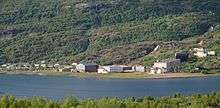
Most trailheads are tiny settlements way off the main roads, so getting there requires some planning and time. If you have a return flight or leave luggage behind, this counts double.
Kautokeino, Kilpisjärvi, Abisko and Kvikkjok are on the trail and should have daily coach (Abisko also train) service, comfortable lodging and shops. Doing some replenishment there should be quite easy. The settlements are small, so check if you need something special. Sulitjelma has a Coop shop, otherwise shopping should probably be done in Bodø or Fauske before taking the bus, which may have sparse schedules at least off peak season.
The other trailheads listed below may be more complicated to get to, but the trail is at least reachable via them by boat or taxi directly or with a moderate trek.
- 🌍 Kautokeino in Norwegian Finnmark. Bus e.g. from Alta. From Finland (via Hetta or Karigasniemi) there should be coach connections in summer, but they might be convoluted. The trail begins 2.5 km from the centre, also Majanasjávri and Reisavann/Raisjärvi farther on are reachable by car via Kautokeino. You could come in by foot from Nordkapp along the E1 hiking trail.
- Saraelv in the Reisa valley can be reached by car or boat (Svartfoss adventure?) from 🌍 Storslett on E6. Bus from Storslett with sparse schedules (not daily). Saraelv is some 45 km upstream along road 865.
- 🌍 Kilpisjärvi, a village in Finland, near the tripoint of Finland, Norway and Sweden. It is on road E8, so easily reachable from e.g. Tromsø in Norway, Haparanda in Sweden or Tornio or Rovaniemi in Finland.
- 🌍 Holt (Øverbygd), with bus from Tromsø via Bardufoss or from Narvik (check!). Hike via Tverelvmo to Rostahytta [?]
- Innset in Bardu (not to be confused with Innset in Rennebu) should be serviced by bus from Narvik at least a few times a week. The local business can fetch customers the 35 km from 🌍 Setermoen, and taxis are available.
- 🌍 Abisko by Abisko National Park is on the Kungsleden trail and also on E10 and the Malmbanan railway between Narvik in Norway and Luleå in Sweden, via Kiruna. You could use a night train from Stockholm.
- Sitashytta is reachable by road up the 🌍 Skjom valley, to a shieling and then on a small road past Iptojávri to Kjårdavatnet (Čoađgejávri), and from there (barrier on the road) with a 2-hr hike.
- Paurohytta or Røysvatnhytta. Reachable by boat (+47 75-77-43-29, call well in advance to allow coordination with other transports) from 🌍 Kjøpsvik in Tysfjord to Sørfjorden, from where trails pass nearby (20 respectively 16 km to the huts, the former trail not properly marked). According to some maps the Nordkalottleden indeed goes via Sørfjorden.
- 🌍 Hellmobotn (Vuodnabahta), also in Tysfjord. Connection by Hurtigruten in summer (Th,F, Su on request, call +47 99-28-32-38). 10 km by trail to Nordkalottleden, at a point 23 km from Røysvatn and 30 km from Vaisaluokta.
- Vaisaluokta, reachable by boat from 🌍 Ritsem, a village by the lake Akkajaure, near the Akka massif. Bus from Gällivare to Ritsem. Vaisaluokta is also the northern trailhead for Padjelantaleden.
- 🌍 Kvikkjokk, a village at the border of Padjelanta National Park, trailhead for Padjelantaleden. Also Kungsleden passes by the village. Bus from Murjek on the main railway or from Jokkmokk on Inlandsbanan.
- 🌍 Sulitjelma, a Norwegian village by the mountains of the same name. Bus from Bodø or Fauske.
Walk
Kautokeino to Reisavann
Kautokeino is an important centre for Sámi culture, on the Finnmarksvidda high plateau.
This leg of the trail (50 km) goes over Finnmarkvidda to Reisavann (Ráisjávri, Raisjärvi), which is the source of the Reisa river. The pleteau is close to the tree line, so the often sparse fell birch forest gives way for fell heath even on low hills. There are many lakes and quite much wetland. The trail goes over the watershed area between the Reisa and Kautokeino/Alta rivers.
The trailhead is at Buletjavri Camping Ground, some 2.5 km from Kautokeino centre. The next cabin is Madam Bongo's cabin (17 km; reachable by car, advance booking required). You could also continue 2 km to Lake Májanašjávri and camp wild. You might also want to camp e.g. between Jeageloaivi (550 m) and the Stáđđejohka river crossing (18.5 km). From there to Reisavann (11.5 km), the trail goes over Rivkkoš (600 m), enjoy the views. If you like another pace, there is no need to camp at the suggested locations.
- 🌍 Buletjavri Camping Ground (some 2.5 km south-south-west from Kautokeino centre). Camping ground (?) by Unna Buletjávrráš. Trailhead.
- 🌍 Madam Bongo's/Cuonovuoppi fell hut (by Lake Májanašjávri). Reachable by road from Kautokeino. 17 km from Buletjavri by the trail. Lodging and meals on advance request.
- 🌍 Stáđđejohka (slopes of Jeageloaivi). Suggested camping site (wild camping). Free.
- 🌍 Reisavann hut (Ráisjávri). Check-in: 17:00, check-out: 17:00. Statskog cabin, half of which for rent, the other half for Fjelltjenesten staff. Electricity, refrigarator, beds for 6 persons. Outhouse, water from the lake. Distance to road 3 km (not maintained in winter; 40 km to Kautokeino by car). Advance booking necessary. 550 kr/night.
Reisavann to Saraelv
The next leg, from Reisavann to Saraelv (60 km), goes through Reisa Nasjonalpark, first continuing on the plateau, partly above the treeline, then in the lush Reisa river valley. There you have the valley itself and the surrounding fells, tributaries dancing down the hillsides, vegetation lush for the latitude and odd geological formations. Elk, bear, lynx and wolverine call the valley home.
If waters are high the trail may be flooded in the valley and tributaries dangerous to ford, a higher unmarked route can then be used instead.
A tent may be necessary on this leg. There are huts along the trail, most unlocked and unmanned, but some are only for two persons. Lodging at Saraelv (Saraelv proper or Ovi Rashiin) should probably be reserved in advance, check key arrangements.
The first 10 km are through fell birch and willow forest as before, the next 10 km on hillsides and ridges mostly above the treeline, with a suggested campsite (15 km from Reisavann cabin). At Luvddiidjohka you can opt for a night in a small turf hut (2 persons).
Before going down in the river valley you can choose between the official trail or a path going close to the impressing 🌍 Imofossen Falls of Reisa. Beside the falls themselves there are odd geological features caused by them. There is a small turf hut (2 persons) upstream from the falls. After the falls the river flows in a canyon for a kilometre and the path follows close to its edge – it can be dangerous, especially after rain when rocks are slippery. At some points along the path you should have good views down the Reisa valley (check where!). If the trail seems problematic you could view the falls as a sidetrip instead.
Regardless of what path you took, you will then descend into the Reisa river valley, where a suspension bridge leads over the river. The Nedrefosshytta hut is close by. It might be possible to have boat transport from here to Storslett.
The Mållesfossen Falls of the tributary Mollesjohka are one of the highest waterfalls in Europe (269 m). You might want to make a sidetrip.
The trail continues through the valley to Saraelv.
- 🌍 Njuolgavárri-Vuolavárit (at a stream between the hills). Suggested camp site (wild camping) Free.
- 🌍 Luvddiidjohka turf hut (turn right after crossing Luvddiidjohka, the hut is some 300–400 m upstream). Small turf hut, space for 2 persons, wood heated stove. Free.
- Imofossen turf hut (Imogammen). Small turf hut. Two persons. Free.
- 🌍 Nedrefosshytta (3 km downstream from Imofossen). DNT key.
- 🌍 Vuommádatkoia (Vuomatakka) (at Nikolaistilla). Two persons. Free.
- 🌍 Sieimma (9 km from Saraelv?). Four persons. Free.
- 🌍 Ovi Rashiin (1 km upstream from Saraelv). Cabin, which works as an unmanned visitor centre for the national park. Check how to get a key for lodging (DNT?).
- 🌍 Saraelv, ☎ +47 930-38-384. Should be reserved in advance.
Saraelv to Kilpisjärvi
The distance from Saraelv to Kilpisjärvi is some 90 km, 24 km more with the side trip to Halti. Most of the leg is above the treline, with little natural shelter and few landmarks in low visibility conditions. Be prepared to cope with fog and storms. From Pitsusjärvi onwards (the trail from Kilpisjärvi to Halti) huts can be crowded in season.
At Saraelv the trail leaves the Reisa valley. It follows an ATV track over easy treeless fell heath terrain to Somasjärvi, 35 km from Saraelv. The border to Finland crosses the lake. The first Finnish hut, Kopmajoki, turns up a few kilometres farther. You are now in Käsivarsi Wilderness Area.
At Pitsusjärvi there is a hut, and the trail forks: turn to the north for a 2·12 km sidetrip to Halti/Hálde, or continue to the south. The highest point of Finland is on the Halti hillside and several of Finland's highest fells are nearby. The top of Halti itself is in Norway, but there is a book to sign at the border. You can use the Halti hut on the way, do not confuse it with the remains of a former hut nearby.
The trail to Kilpisjärvi leads to the south towards Meekonjärvi along Pitsusjoki. About 1.5 km from the lake, there are the 17 m high 🌍 Pihtsusköngäs Falls (Pihtsuskordsi). At Meekonjärvi there is a day hut, a reservable hut and an open wilderness hut, spread around by the shore. There is a demanding canoeing route from here down to Karesuvanto and all the way to Tornio/Haparanda by the Gulf of Bothnia – demanding also in that you'd have to carry the canoes here from Kilpisjärvi if you go independently.
From Meekonjärvi the trail continues via the Kuonjarjoki and Saarijärvi huts, taking a shortcut through Norway, and ends up in Kilpisjärvi. Saana, overlooking Kilpisjärvi, is one of the most famous fells in Finland. The trail to the top features the longest stairways in the country.
Close to Kilpisjärvi there are several trails. Depending on your plans you might want to take one leading to the intended end of the village, to avoid a 5 km hike along the road to get to your dinner or bed.
- 🌍 Somasjärvi hut (Somášjávri) (at lake Somasjärvi, 35 km from Saraelv).
- 🌍 Kopmajoki. Open wilderness hut. Free.
- 🌍 Pihtsusjärvi hut (Bihčosjávri). Wilderness hut with open and reservable part.
- 🌍 Halti hut. Open wilderness hut. Free.
- 🌍 Meekonjärvi reservable hut, ☎ +358 20-639-7990 (booking), e-mail: kilpisjarvi@metsa.fi. Bunk beds with mattresses, pillows and blankets. Stove and gas cooker. Basic cookware (pot, frying pan, coffee pot). Pets are not allowed. Check where to fetch the key (probably in Kilpisjärvi, but info on exact location is conflicting, and you might be able to make some arrangement). €12/person.
- 🌍 Meekonjärvi open wilderness hut (500 m farther from the reservable hut). Beds without mattresses. Stove and gas cooker. Free.
- 🌍 Kuonjarjoki.
- 🌍 Saarijärvi. huts
In Kilpisjärvi there are restaurants and cafés, shops and commercial lodgings. The fell Saana dominates the view. The Kilpisjärvi Visitor Centre has information, exhibitions and films on Malla Strict Nature Reserve, Saana Nature Reserve and Research Area, Käsivarsi Wilderness Area and the residents of the area. Some souvenirs.
Kilpisjärvi to Innset
The Swedish Pältsa hut belongs to STF and in Innset there is accommodation at the husky farm not associated with DNT. Otherwise the huts mentioned here are unmanned and locked with the DNT key, belonging to Troms Turlag. You can get the key e.g. from the customs in Kilpisjärvi, for a deposit. The key for the reservable department of the Kuohkimajärvi hut can be got at the customs or from the visitor centre (which one?). Check arrangements.
There are several fells reaching 1400 or 1500 m, the trail mostly staying below 1000 m. Landscapes are varied, with fell birch forest, wetland (with or without duckboards), easy to walk fell heath (moorland) and higher rocky stretches. There are bridges, but also rivers that have to be forded. Most fords are easy under normal circumstances, but early in the season or in rainy summers some may be problematic.
The trail from Kilpisjärvi leads through Malla strict nature reserve to the tripoint between Finland, Norway and Sweden (11 km). In the reserve deviating from the trail is not permitted. There is a side trip (1.5 km) to Pikku-Malla, with a good view over the lake. In the summer one can also take a boat over Lake Kilpisjärvi, leaving only 3 km walking. There is a hut at Kuohkimajärvi near the tripoint. There is a parallel trail on the Norwegian side, from the E8 road to Goldahytta, do not confuse the two when getting advice.
The trail enters Sweden at the tripoint and soon descends into the lush Pältsa valley. The Pältsa hut (14 km) is manned in season, with sauna. It was used as a base for Norwegian resistance during WW2. The E1, which has coincided with Nordkalottleden from Kautokeino enters Norway instead, for a more northern route via Goldahytta hut 3 km from the tripoint (Stordalen in the west was a refugee route during WW2, as there are plenty of hiding places; Finnish mobile phone coverage) and Gappohytta hut a further 14 km away, below the 🌍 Paras fell (Sámi: Bárrás). The two trails meet again just before Rostahytta in Norway (12 km after Pältsa). The stretch where Nordkalottrutten does not follow other trails is only a few years old and not necessarily yet worn, follow markings and your map.
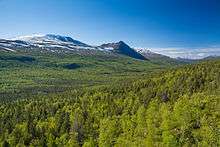
The next huts are Dærttahytta (18 km), and Dividalshytta (24 km) in Øvre Dividal National Park.
[...] Vuomahytta (18 km) – Gaskashytta (17 km) – Altevasshytta (13 km) – Innset
After Gaskashytta you cross the Luotnajohka rivers by bridge and continue by the Altevatnet/Aldddesjávri lake, crossing the Koievasselva by bridge, some wetland and by bridge over Vasskardselva. When you reach Altevasshytta (13 km) close to the Altevass dam, you are 140 km from Kilpisjärvi. There are quite many summer cottages by the lake, but the year-round inhabitants of Innset are few.
From Altevasshytta you can follow the road 5 km downstream to reach the small village Innset with a husky business with accommodation, sauna and other services, and the 35 km road to Setermoen, the Bardu municipal centre on E6 (transport with the husky business 700 kr, taxi a little more, there might also be a bus).
Otherwise you continue south towards Abisko in Sweden.
- 🌍 Kuohkimajärvi wilderness hut (near the tripoint). Wilderness hut and reservable wilderness hut. Free or €12/person.
- 🌍 Pältsa hut. March–April, 20 June–15 September. STF manned hut. Sauna. Pets allowed in some rooms. Payment in cash only.
- 🌍 Goldahytta hut. DNT obetjent cabin.
- 🌍 Gappohytta hut. DNT obetjent cabin.
- 🌍 Rostahytta. DNT obetjent cabin.
- 🌍 Dærtahytta.
- 🌍 Dividalshytta. DNT obetjent cabin.
- 🌍 Vuomahytta. DNT obetjent cabin.
- 🌍 Gaskashytta. DNT obetjent cabin.
- 🌍 Altevasshytta. DNT obetjent cabin.
- 🌍 Huskyfarm Innset, Innset, 9360 Bardu, ☎ +47 77-18-45-03, e-mail: info@huskyfarm.de. Former farm transformed to tourism business. Also offers just lodging, sauna and laundry. 360 kr/person (linen not included), children 7–16 150 kr, cabin (6 pers.) 1650 kr.
Innset to Abisko
There is a road below the Altevatnet dam. You will then walk a somewhat less used trail, with three river crossings, which should have bridges (but they have sometimes been damaged by floods). Above you is the 1336 m Salvasskardfjellet (Northern Sámi: Noaidun). Halfway to the Swedish border, in the Láirevággi pass at 960 m, you enter Rohkusborri National Park.
28 km after Altevatnet you reach the last Norwegian cabin, Lappjordhytta. After the hut there is a steep descend towards the Swedish border and Torne träsk, the seventh largest lake in Sweden (332 km², at 340 m). There is a small open hut at the shore, Pålnostugan, unmanned with emergency phone. The trail continues more or less along the shore. The last distance to Abisko the trail follows the Malmbanan railway between Luleå and Narvik.
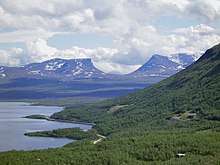
- 🌍 Lappjordhytta. obetjent hytte, DNT key. Mobile phone coverage from Sweden.
- Pålnostugan. Unmanned wilderness hut. Emergency phone.
- Abisko.
The village Abisko (Ábeskovvu) has a station on the railway (Abisko Östra) and Abisko turiststation another, by the visitor centre for the very popular Abisko National Park and a fjällstation, with lodgings for some 300 tourists. Abisko is also the northern trailhead to Kungsleden, the most famous hiking trail in Sweden.
Abisko to Sälka
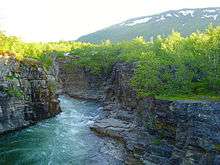
The distance from Abisko to Vaisaluokta by the trail is nearly 300 km. It first leads by the famous and popular Kungsleden to Sälka, then up in the wild Narvik mountains. Most of it is above the treeline, partly around 1000 m high (with no lower valleys in easy reach). Make sure you are prepared. You can get some provisions in Sälka, but you might want to check in Abisko what they have (the folks in Abisko should at least have an idea).
From Abisko to Sälka (60 km), the trail coincides with Kungsleden. Soon after Abiskojaure fjällstuga (13 km) you reach the treeline. After the next cabin, Alesjaure fjällstuga (20 km) you are definitely above it. The trail continues via Tjäkta fjällstuga (12 km) to Sälka fjällstuga (12 km). The pass after Tjäkta fjällstuga is the highest point of Kungsleden at 1100 m. After Sälka Kungsleden continues to the south passing Sweden's highest mountain, Kebnekaise (2093 m; 10 km from Sälka), while Nordkalottleden continues westwards to Norway.
All the cabins from Abisko to Sälka have emergency phones.
- 🌍 Abiskojaure fjällstuga. Sauna and shop.
- 🌍 Alesjaure fjällstuga. Sauna and shop.
- 🌍 Tjäktja fjällstuga.
- 🌍 Sälka fjällstuga. Sauna and shop.
Sälka to Vaisaluokta
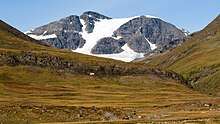
Sälka is probably the last hut with food for sale before returning to Sweden after a week of trekking. The Norwegian ones from Gautelishytta onwards belong to Narvik og Omegn Turistforening. They are unmanned and have neither food nor emergency phones. You need the DNT key for them.
From Sälka the trail leads by Hukejaure fjällstuga (20 km; backtrack 2 km in the morning) to the border and continues meandering between the countries via Gautelishytta (17 km), Skoaddejávre hytta (17 km), Sitashytta (22 km), Paurohytta (24 km), Røysvatn hytta (25 km) and Rávddajávrre shelter (40 km) to Vaisaluokta fjällstuga (13 km). From Gautelishytta to Sulitjelma it coincides with the Nordlandsruta trail at least partly [check route]. There is no food for sale before Vaisaluokta, so you have to have food for a week when you leave Sälka. You can get fishing permits, but do not rely on the catch.
It is possible to take a shortcut from Hukejaure via 🌍 Sitasjaure (20 km) to Ritsem (20 km), from where you can take the boat to Váisáluokta or the coach to Gällivare as described below. This may be sensible e.g. if you are running out of days or the weather makes a week in high fells seem a less good idea.
In the Narvik fells the trail is at quite high altitude, with very nice views but exposed in bad weather. Fog can make some of the huts hard to find. There may also be snow and ice left late in the summer, check especially if going before July. There are many glaciers in the mountains around the trail, some visible also from the trail.
After Paurohytta you cross Bårojávrre by the narrow isthmus. There is a sound in the middle, with rowing boats. You might have to cross three times to leave a boat on each side. If the boats were on land, leave them in the same way. A variation of the route goes from Pauroshytta via Sørfjorden and then along Gränsleden (36 km from Paurohytta to Røysvatn by this route).
After Røysvatn the trail crosses the Gränsleden trail (Rádjebálges, Grenseleden) from Sørfjorden in Tysfjord (boat connection from Kjøpsvik) in Norway over the border mountains to Ritsem in Sweden. This is an old trade route, and was also used by refugees during the war. Rádjebálges has several lean-to shelters (but no huts) on the 40 km leg from here to Ritsem. There is a boat connection from Ritsem to Váisáluokta.
The last leg between Røysvatn and Vaisaluokta is 50 km without cabins, mostly in exposed terrain. You could instead walk along the Gränsleden trail (Rádjebálges) from Røysvatn to Ritsem and take a boat from there to Váisaluokta over Áhkkájávrre.
20 km farther it is possible to walk the 10 km down to Hellmobotn, which is reachable by Hurtigruten in summer. This is the narrowest point of the Norwegian mainland (except near Kirkenes), only 6 km from fjord to border.
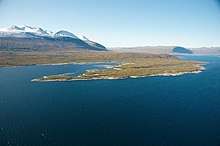
Back in Sweden after Røysvatn the trail slowly descends below the treeline again. Váisáluokta is a Sámi settlement by the large lake Áhkkájávrre, home to about fifty families. You can buy smoked fish and gáhkku from the locals. There are two goahti churches near Svjálltjájåhkå. Nearby is Áhkká, towering over the lake 2015 m high (the lake is at 450). Áhkká is a goddess in the Sámi pre-Christian religion. Seem from the right perspective one can see her head, breasts, belly and legs. A large number of terrain features caused by the glaciers can be identified below the mountain.
From Váisáluokta there is a boat connection to Ritsem, with coach connection to Gällivare. The Padjelantaleden leads (or used to lead) to Änonjálmme 7 km further south by the shore. Also Änonjálmme is a Sámi settlement.
- 🌍 Hukejaure fjällstuga.
- 🌍 Gautelishytta. Unmanned (obetjent) DNT hut. Sauna. Boat.
- 🌍 Skoaddejávre. Unmanned (obetjent) DNT hut. Hard to find in fog. Boat. Fishing possible if you have the permit.
- 🌍 Sitashytta. Obetjent hytte. Closed road from the fjords, used by bikers and families with prams. Boat. Fishing possible if you have the permit.
- 🌍 Baugeboa. Emergency or day hut. Two beds. Built 2016.
- 🌍 Paurohytta.
- 🌍 Røysvatn hytta (check position, wrong on at least one map, may be hard to find in the terrain). Obetjent hytte. Sauna.
- 🌍 Rautojaure (Rávddajávrre). Day/emergency hut. Beds for two, space for two more on the floor. No heating.
- 🌍 Vaisaluokta (Vájsáluokta). Operated by STF. Only accepts cash payment. The cabin does not have a shop, but you may be able to buy some food from the settlement.
Vaisaluokta to Staddajåkkå
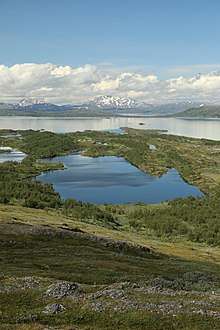
From Váisáluokta fjällstuga the trail goes via Kutjaure fjällstuga (18 km), Låddejåhkå fjällstuga (19 km), Arasluokta fjällstuga (13 km), Stáloluokta fjällstuga (12 km) and to Stáddajåhkå fjällstuga (12 km). The Padjelantaleden coincides with Nordkalottleden for some distance, at Stáloluokta it forks away to the east, to Kvikkjokk.
The leg from Stáloluokta to Kvikkjokk along Nordkalottleden is some 100 km. You could take the shortcut along Padjelantaleden, via Tuottar (18 km), Tarraluoppal (11 km), Såmmarlappa (13 km), Tarrekaise (13 m), Njunjes (6 km) to Kvikkjokk (16 km), for a total of 77 km.
Kutjaure fjällstuga is at the border of the Padjelanta (Badjelánnda) National Park. The cabins in Padjelanta are operated by the Sámi Badjelánnda Laponia Turism (BLT). 10 km to the south-east is Sarek, which is the most demanding national park in Sweden, with high mountains (several peaks over 1900 m, Sarektjåhkkå 2023 m) and little infrastructure. Both of these parks, as well as the Swedish part of the Sulitelma mountains, are part of the UNESCO World Heritage site Laponia.
Because of the reindeer, dogs are not permitted in Padjelanta, except as leashed 1 January–30 april. The name Badjelánnda means "high land" and much of the park is fell heath, surrounded by higher peaks outside the park.
At Staddajåkkå fjällstuga Nordkalottleden forks. If you go to the west, you end up in Norwegian Sulitjelma, if you go south, in Swedish Kvikkjokk. The trails lead by Swedish Sulitelma on different sides.
- 🌍 Kutjaure (Guvtjávrre). Operated by STF. Only accepts cash payment. Does not have any shop. Mobil phone coverage shaky. Emergency phone. The settlements near the lake belong to the Sámi community Sirges, while the cabins are maintained by STF.
- 🌍 Låddejåhkå. Operated by BLT. Sells a few edibles.
- 🌍 Árasluokta, ☎ +46 73-082-33-69. Operated by BLT. Sells a few edibles (including smoked or fresh fish, dried reindeer meat, gáhkko) and some Sami handicraft. Boat tours available. Church goahti at the Sámi settlement.
- 🌍 Stáloluokta. Operated by BLT. The Stáloluokta cabins are situated by a Sámi settlement and, like the other cabins in Padjelanta, maintained by the Sámi community. Sauna and Church guohti. The Parfas kiosk (+46 73-812-1649) sells food, including dried reindeer meat, fresh fish and a basic assortment of normal non-perishable food, and various daily or camping essentials.
- 🌍 Stáddájåhkå. Operated by BLT. Home made bread and a minor assortment of non-perishable food for sale.
Staddajåkkå to Kvikkjokk
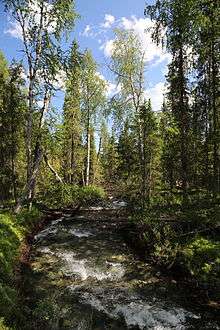
From Staddajåkkå fjällstuga you can continue via Pieskehaure fjällstuga (29 km), Vaimok fjällstuga (18 km), Tarrekaise fjällstuga (22 km), Njunjes fjällstuga (6 km) to Kvikkjokk fjällstation in Kvikkjokk (16 km).
There is a mighty glacier view at Pieskehaure fjällstuga. The highest peak, Suliskongen (1907 m), can only be reached by a long glacier walk, which would require a guide.
Lake Vájmok is said to be the one with clearest water in Sweden.
Descending down to Tarrekaise the trails leaves the treeless areas. From Tarrekaise fjällstuga (at lake Tarraure) the trail again joins Padjelantaleden, to Kvikkjokk. After Njunjes it reaches coniferous forest.
- 🌍 Pieskehaure fjällstuga. Sauna, shop and emergency phone.
- 🌍 Vaimok fjällstuga.
- 🌍 Tarrekaise (Darregájsse). Operated by STF. Has a shop, but only accepts cash payment.
- 🌍 Njunjes fjällstuga.
- Kvikkjokk fjällstation (Huhttán) (in Kvikkjokk), ☎ +46 971 210 22, e-mail: info@kvikkjokkfjallstation.se. Operated by STF. One of the largest mountain stations in the reserve. They have a convenience store and a restaurant. They also rent out fishing and canoeing gear.
At Kvikkjokk mountain station the rooms have hostel standard. Restaurant with buffet meals; bar and café; shop. Kvikkjokk became an important place in the 17th century because of a silver mine in the nearby mountains (laid down 1702, some structures in Kvikkjokk remain). Now it is the trailhead for Padjelantaleden, Kungsleden and Nordkalottleden, as well as for shorter hikes. Guided boat and canoe tours available. Among those not arriving from the fells, the place is regarded as being in the middle of the wilderness.
Bus from Kvikkjokk to Jokkmokk at Inlandsbanan (120 km) and Murjek at the main railway (180 km). Both provide access to sleeper trains to Stockholm.
Staddajåkkå to Sulitjelma
To Sårjåsjaure fjällstuga (6 km), over the border and via Sorjushytta (9 km) and Ny Sulitjelma fjellstue (7 km) to Sulitjelma (3 km). The trail passes between the Sulidälbmá/Sulitelma/Sulitjelma and Blåmannsisen glaciers, the latter 5th in size in Norway. Remember that approaching the front of a glacier or walking on it is very dangerous. The glaciers can safely be admired from a suitable adjacent peak (which requires some planning and probably a separate day trip) or from safe distance.
The Sårjåsjaure cabin is also known as Konsul Persson’s cabin, as it was built because of his daughter (beds are original, smaller than modern standard). By the cabin is the glacier lake with a sandy beach, and a waterfall. The cabin is unmanned according to DNT, and there may be no firewood.
A new Sorjushytta cabin was built after a storm 2006. The old one can still be used (and should be used if you have a dog). Obetjent.
The new Ny Sulitjelma hut (obetjent) has running water and electricity. The older, nowadays little used house (use it if you have a dog) served the mine (mining stopped 1991). Traces of the mining in the surroundings. In summer you can come here by car from Sulitjelma. After the cabin there is a fork to the east, along which the European route E1 continues towards Sicily.
- 🌍 Sårjåsjaure (Sårjåsjávrre). Operated by STF. Sells a few edibles.
- 🌍 Sorjushytta. Unmanned ("obetjent") cabin. DNT key.
- 🌍 Ny Sulitjelma fjellstue. Unmanned ("obetjent") cabin. DNT key.
- Sulitjelma (Pite Sami: Sulidælbmá, Lule Sami: Sulisjielmmá) is a former mining town, now a trailhead for treks to the nearby glaciers and fells, as well as for Nordkalottleden.
From Sulitjelma you can take road 830 to Fauske. Buses to there and onwards to Bodö.
Stay safe
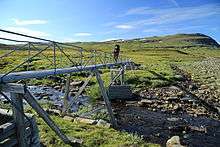
Make sure you bring adequate clothes and equipment, and be prepared to help yourselves for quite some time whatever happens. The weather can change very quickly in these areas.
Make sure somebody knows your timetables and calls for help if you do not send a message when you should – but make arrangements for your being belated while still being safe, or your not being able to send the message because of lack of signal. The one responsible for calling the emergency services should understand these issues. Use text messages instead of calling when possible, and keep data off, to save power. Text messages also work with weaker signal than a call (and can on many phones be queued while waiting for signal).
Emergency services are reachable on 112, if you have signal. Your call may be answered on any side of the border, but the emergency services should be well coordinated, so you do not have to worry about that. Make sure your batteries do not go flat – as they will if you use your phone for navigation. Only a few of the huts have electricity for charging batteries, none on many legs. Also remember that electronics dislike moisture. Keeping the phone off in a sealed plastic bag may be a good solution.
Do not rely on mobile phone coverage. Much of the area does have coverage, and often (but not everywhere) you get signal at least if you climb a suitable hilltop. In any case searching for signal implies you should be ready to send somebody away to make the call, or failing that to find other people, while somebody else should be able to take care of the one who got ill or injured, with the equipment you brought. On some legs there is enough people that somebody might turn up soon enough, but with bad luck you would have to wait a week or more on other legs.
Most Swedish huts on the trail have emergency phones, now called hjälptelefon ("help phone") in Swedish. That means that you can call for help if you reach one of the huts, but you are also encouraged to use them to prevent emergencies, e.g. by getting advice, and to tell about your being delayed. They can not be used for calling arbitrary numbers, but connect to the emergency services.
Go next
- Kungsleden continues to the south from Kvikkjokk for some 255 km more of trekking, with Vindelfjällen in the south end being the largest nature reserve in Sweden, at 5,500 km2 (2,100 sq mi). The trail ends in Hemavan.
- European long distance path E1 continues to the north from Kautokeino, ending at Nordkapp, and to the south from Sulitjelma (a fork to the east between Ny Sulitjelma cabin and the village), ending in Sicily.